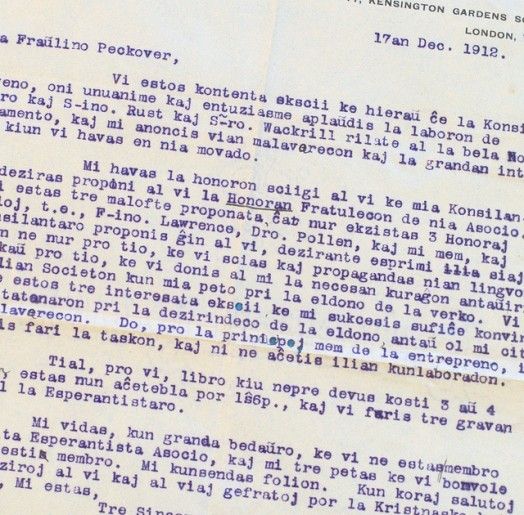[dt_button link=”http://d165vjqq8ey7jy.cloudfront.net/mp3/19237/se-7084s.mp3″ target_blank=”true” button_alignment=”default” animation=”fadeIn” size=”small” style=”default” bg_color_style=”custom” bg_color=”#333333″ bg_hover_color_style=”custom” bg_hover_color=”#444444″ text_color_style=”custom” text_color=”#ffffff” text_hover_color_style=”custom” text_hover_color=”#dddddd” icon=”fa fa-cloud-download” icon_align=”left”]Yuklash[/dt_button]
[dt_divider style=”thin” /]
Transcript:
Voice 1
Welcome to Spotlight. I’m Liz Waid.
Voice 2
And I’m Adam Navis. Spotlight uses a special English method of broadcasting. It is easier for people to understand – no matter where in the world they live.
Voice 3
Saluton.
Voice 4
Saluton. Kiel vi fartas?
Voice 3
Bonege, dankon.
Voice 1
Did you recognize that language? It sounds European – a little like Spanish, or German. But it is neither. It is called Esperanto. You may have heard Esperanto before! It is the most popular invented world language. Today’s Spotlight is on Esperanto.
Voice 2
Conflict and troubles affect people in different ways. They make some people want to run and hide. And they make other people feel angry at the world and the people in it. But some people try and find a way to change things.
Voice 1
Ludovic Lazurus Zamenhof was one of these people. Zamenhof was born in 1859. He lived in the city of Bialystok, Poland. At that time the city was part of Russian territory. There were three major ethnic groups in the city; Poles, Belorusians and Yiddish-speaking Jews. The conflicts between these groups saddened the young Zamenhof. As a Jew, life was not easy. Several hundred years ago many Jews fled to Poland for safety. But conflicts continued. Even children were part of the conflicts. They had fights in the schools and on the streets. Zamenhof grew up in an environment of deep hatred and fear.
Voice 2
However, Zamenhof did not feel hatred and anger in his heart. Some people say that his mother helped to create his good nature. His mother believed that all human beings were children of a loving God. The young Zamenhof began to think of ways to change the hostile environment he lived in.
Voice 1
Zamenhof believed that language barriers were a big part of the problem. He thought that if all people could speak the same language, they would communicate better. As a child, he believed that a common language would end hatred. He dreamed of an end to political and racial hatred. He dreamed of a united world.
Voice 2
Zamenhof began experimenting in creating an international language. In the beginning he tried to create a language with rich grammar. But this became very complex. Zamenhof learned many languages, including German, French, Latin and Greek. He decided that the international language must be as simple as possible. He worked hard for many years. He began by ‘testing’ the language.
Voice 1
How do you test a new language? Well, Zamenhof tried translating existing books, stories, prayers and parts of the Christian Bible. Let us hear how Esperanto sounds!
Voice 5
“Cio estigis per li; kaj aparte de li estigis nenio, kio estigis. En li estis la vivo, kaj la vivo estis la lumo de la homoj. Kaj la lumo brilas en la mallumo, kaj la mallumo gin ne venkis.”
Voice 1
In English this means, ‘And with this Word, God created all things. Nothing was made without the word. Everything that was created received its life from him. And his life gave light to everyone. The light keeps shining in the dark. And darkness has never put it out.’
Voice 2
After Zamenhof had tested the language he needed to publish his book. He called it, ‘Lingvo internacia. Antauparolo kaj plena lernolibro.’ This means ‘International Language. Foreword and Complete Textbook.’ Zamenhof did not put his real name on the book. Instead he used the name ‘Doktoro Esperanto.’ This means ‘Doctor Hopeful.’
Voice 1
So let us take a closer look at Esperanto. About 75% of the words come from Latin and Romance languages like French. About 20% come from German and English. And the rest comes from Russian, Polish and Greek. 28 letters form the Esperanto alphabet. And the language is ‘phonetic’ – you say every word exactly as it is written. There are no exceptions. Most of the grammar of Esperanto follows one of 16 basic rules.
Voice 2
In Esperanto all nouns end with ‘O’. For example the noun bird is ‘birdo.’ If you have more than one bird it becomes ‘birdoj’.
Voice 1
Here is another interesting thing. If you add ‘mal’ to the beginning of a word, it gives the word the opposite meaning. For example – alta means tall. Malalta means short. Seka means dry. Malseka is wet. Pura is clean. Can you guess what dirty is? Malpura!
Voice 2
No one knows exactly how many people speak Esperanto. Some people estimate around 2,000,000. This is based on information such as sales of Esperanto language books and Internet users. Esperanto is most common in Central and Eastern Europe. Speakers of Esperanto have developed some similar customs. But, many people argue that an ’international language’ should not have its own culture. They say that an international language should avoid cultural and racial divides.
Voice 1
Speakers of Esperanto say that the language makes communication easier when travelling. They say that Esperanto is a good second language – better than others like French, Spanish or English.
Voice 2
People in many places in the world use these languages – more than Esperanto! But there are also many native speakers of these languages. The idea of Esperanto is that it makes everyone equal – because it does not ‘belong’ to any particular group. It belongs to the international community! Zamenhof hoped that this would unite people – and help create a peaceful world.
Voice 1
Most people argue that language alone cannot create peace. People in the same country, with the same language and culture still argue and fight.
Voice 2
Zamenhof was an idealist. He believed that the world could change. After all, the language is called ‘Esperanto’ – ‘one who hopes.’ And a person who has hope can do more than a person without hope! Zamenhof did not see his dream in his lifetime. There is still misunderstanding between people. But Esperanto has united many people across the world. It has crossed at least some cultural and racial divides. On an international website for Esperanto speakers, one person wrote,
Voice 4
“Being a speaker of Esperanto means that I am part of a worldwide community. They are people who believe in equality – like me. There are sayings like ‘We are all born equals.’ Esperanto lets people express these ideas.”




